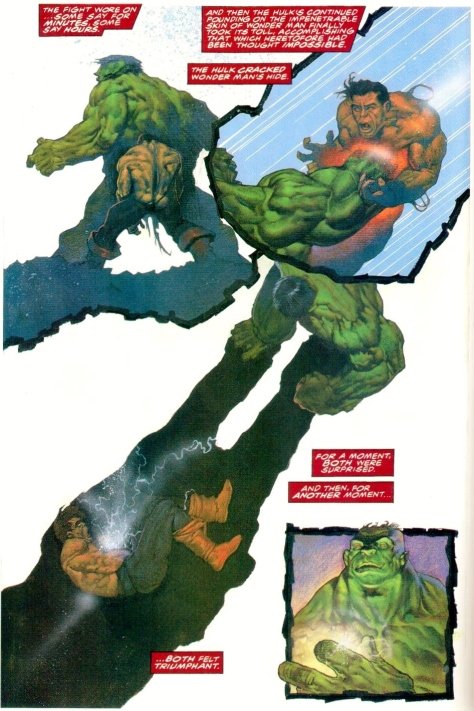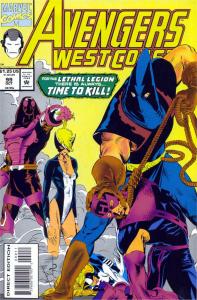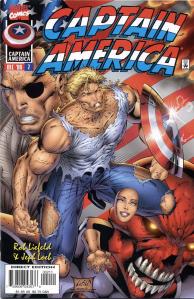“Boyoboy, a pointless scuffle. Just like old times…” – Hawkeye
Have you seen “Marvel’s The Avengers: Age of Ultron”? I assume you have. We here at the Unspoken Decade have. This month we want to share our boundless enthusiasm for all things Avengers with you and are taking a closer look at some of our favorite Avengers’ stories.
In 1995 Peter David wrote his first and only (aside from the “Season One” OGN) Avengers’ story, “The Last Avengers Story,” featuring the first American work of Argentinian artist Ariel Olivetti. Seeing print alongside such avant-garde alternate reality stories as Warren Ellis’ “Ruins” and Garth Ennis’ “Punisher Kills the Marvel Universe,” it is a trip through the bleak wasteland of the far future of 2016. It is also the story of the “last” Avenger, the man, the myth, and the legend himself, Hank Pym.

This is not a comic about hope. It is not a comic about why you would want to be a superhero. This is a comic about what happens when you are a superhero, even if you cannot help it. Most importantly, this is a comic about family. “The Last Avengers Story” features cameos and appearances by many notable Avengers and some members who were, at least at the time, candidates from some weird future. This includes Cannonball, the Nigh-Invulnerable Man (sort of like “The Human Rocket” except with even more innuendo), so we can assume Jon Hickman was a fan. One notable absence is Tony Stark.
At no point during the two issue, prestige-format limited series does anyone acknowledge the fate of the team’s longtime benefactor or his “armored bodyguard.” Instead the story focuses on and shows the fruit of the Pym family tree. As if the entirety of what the Avengers are had been focused through the lens of Hank Pym, the doughy, porn-‘stached form of Hank Pym.
Have you ever had to acknowledge anything sadder than that?
In a world without the Avengers (it has been about two or three decades since we last saw the originals “in action”), things merely moved on. The Avengers became a poorly run franchise full of unlikable, younger heroes that are (since this was 1995) promptly “nuked” from existence.

When we first meet Hank (again) he is retired (again) and desperately trying to repair things with Jan van Dyne (again). The difference here is that this is the beginning as opposed to most Hank stories, where the failure comes later. Years after he first provided superpowers to a young woman in hopes of having her like him, the Wasp has begun to shrink, about an inch a year, and it is not to enhance her abilities. One of Hank’s only unobstructed accomplishments is killing the one person he loves more than life itself, and, as far as we are shown, Hank is no closer to solving the dilemma after a decade of constant work.
Hank has grown fat and watched the world slowly become unrecognizable. There are references made to Greenwich Village becoming an unlivable hellhole, while the South Bronx has become trendy and fashionable. If you are not intimately familiar with the various neighborhoods in and around New York this is not that important, but if you are, well, then I guess we could have worse instances of world-building. If nothing else, these issues escaped Peter David’s incessant obsession with puns. The heroes never made the world better. No grand change was made to how man and superman live together and without the constant focus of monthly adventures to distract our heroes they slumped into the same mediocrity that we ourselves can one day expect.

My favorite Avenger, Clint Barton (referred to as “Cliff” at the beginning of the second issue because either Mockingbird has some undiagnosed memory issues or no one cared enough about the Avengers to copy edit) is retired and blind, lamenting the loss of the good old days. Bobbi Morse, his wife, hates everyone because Kirby-forbid that character ever to be likable. As another reminder that the world became worse, we are told that President Captain America was assassinated some time ago, under mysterious circumstances that remain unsolved.
Next is Ultron-59, scion of the House of Pym, who has come to issue a challenge: Whatever heroes Hank can muster (the “real kind,” not these “pale imitations of today,” sounding similar to more than one aged fanboy I have met) versus the surviving forces of evil. This, we are told, will be for all the marbles but is one more instance of a child acting out for attention. Not only was he the one who annihilated the New Avengers in one fell swoop, but, to really drive home the point, he pulls out a cigarette and lights it with his eye beams. Take that, Dad! I can choose to smoke, even though I am an unconquerable killer robot. Alongside him is the Grim Reaper, this time played by Billy Maximoff about a decade before, and a world over, becoming Wiccan of the Young Avengers.

His twin brother Tommy is also around, apprenticing as the Sorcerer Supreme. Their father, the Vision, makes an appearance as we are shown why the Scarlet Witch and Quicksilver are no longer around. This is Hank’s extended family. The wife he could never quite figure out how to love, the son he never intended to have, the grandson he could never have fathomed, and the two great-grandchildren he now must simultaneously fight against and lead into battle.
Reaper is joined by Kang the Conqueror and a shapechanger named Oddball. “The Last Avengers Story” is a story within the story as well, used by Ultron-59 to lure Kang back to this decade because reasons. The nature of Oddball’s relationship to Grim Reaper, which is portrayed as important, is never explained. I like to believe he is the first, non-canonical appearance of Teddy “Hulkling” Altman. In a world apparently constructed around Hank, everyone suffers and no one is truly happy. Even a character that had yet to be created, such as Hulkling, appears to be retroactively sucked into this void. Instead of the Next Generation of Heroes there is a homicidal maniac (Billy), an indecisive shut-in (Tommy), and a pile of nonsense molded to look like a Simon Bisley drawing (Teddy).

The cinematic world of the Avengers is one built by and around Tony Stark. In some cases the fact that he flies around as Iron Man is secondary. He built Ultron, gets credit for bringing the Avengers together, and is in the center of all those group-shot movie posters, inexplicably not wearing his helmet even though they are in the heat of battle. The world of “The Last Avengers Story” eschews Cocktail Shaker Man and focuses on the parts of the Avengers that stem from Hank Pym, a character who has yet to appear in any movie.
Part of that is not his fault; my understanding is that the Ant-Man film was green-lit way back when the first Iron Man film was getting made, so those characters were sequestered away. Still, I cannot imagine Tony Stark being that upset if Ultron-59 came to his door and demanded a Final Battle to get over his Daddy Issues. Tony, unlike Hank, will have moved on, and an Ultron built by him may not end up as needy as one built by Hank. With each reread I am surprised how dark the world presented here is.

This story is a tragedy but it is also funny, the humor coming from the absurdity of the situations these also-rans find themselves in. Wikipedia tells me that this comic was written in 1986 and was shelved until the powers that be decided to temporarily replace the “What If?” brand with the darker, and more expensive-per-issue, “Alterniverse” brand. That means that instead of being a contemporary of “The Crossing,” the much maligned Avengers event that shipped merely two months before this far better remembered story, this should actually be considered a peer of Peter David’s own “The Death of Jean DeWolff” and the other boundary pushing stories of the eighties. This is not a parody of the era it found itself in, but is really one of its precursors. I am not sure what of David’s original scripts made it onto the page. There is a reference to the also much-maligned reveal of Alicia Masters as a Skrull from a few years before (She and Johnny Storm, also a former Avenger, have an adult child that Pym attempts to enlist).
This story felt as if it could have been the future that the Marvel eighties promised, an era of Jim Shooter, Frank Miller, and a slow transition from Bronze to Dark. It was not a place of hope, and the noble tended to be ground down. Pym tells his motley crew that he wishes Captain America was there, to lead them, inspire them, and most of all to tell them what to do. Thor, Hercules, and other mythic characters have all perished in a separate, unrelated great disaster. This leaves the team constantly wondering why they should bother, which encapsulates what the Avengers are, both as a team and a franchise. They are not the Justice League. They are not the best of the best, they are the other guys. They constantly change their lineup and most of their greatest foes are former teammates. They occupy a pronounced space in popular culture that can be uniquely self-defeating.
To watch them flounder with existential despair while in the midst of their last great struggle shows that maybe this is what being a hero is. Fighting for what you believe in, no matter the odds, and hoping against hope that your faith in your friends will be enough to see you through. Except if you are Hank “Seriously, I went back to using the name Yellowjacket even after that Salvation-1 business (but that may have actually been a Skrull)” Pym. Then you wait until things get heated, grab your wife, and try to hightail it to the Microverse. My single favorite moment in this comic, possibly in all of Avengers fiction, is the look on Jan’s face as she realizes what Hank is proposing and that he is ready to go, no questions asked. He has thought about this. Amid the carnage and bloodshed of their friends and superpowered children fighting for their lives against a monster Pym himself created, Hank is ready to run away and hide. In fact, that was his plan all along.

Hank’s not the noble, inspirational figure of the story, at least not this one. He is not supposed to be. Those who are wear capes, gives speeches, and maintain even heart rates as they calmly tell mad gods to go ☠☠☠☠ themselves. Hank is the one who makes those people shine brighter by comparison. Captain America is a great man in story, but is he an interesting character? When he has something to fight against, sure. When he is disillusioned and coming up against something that makes him question what he believes in or how those beliefs are portrayed in the world. Hank does not have ideals; he just tries to follow those who do. You cannot write compelling fiction about a person who only does good. The writers of “Action Comics” for the last thirty or so years can tell you that.
“The Last Avengers Story” is about the legacy of a man who was there at the beginning of an idea and who sees it through to the end. Hank is murdered by a time traveling former pharaoh who may have once banged his “niece” (again, in another world). His has been a weird life made all the more strange by the fact that he never once made a decision he could really be proud of and that said decisions come back to haunt him in his twilight years. This is not “The Dark Knight Returns,” and the hero does not prove everyone else wrong. Hank, potbelly intact and with only a few flaccid devices at his disposal, can only defeat his villainous son (who should have been Hank’s legacy considering he created AI alone in his basement) by being murdered by an underling.
Hank falls, Ultron slaughters Kang, the man responsible for stealing his victory. Fearing that Ultron will now never know his true purpose he is then murdered by his own son, the barely coherent Vision, moved to action by the death of his “grandfather.” A vicious, awful cycle comes to an end, the dead are buried, and the survivors are left to wonder whether any of this was worth it. There are no celebrations and as far as I can tell Jan is still shrinking, slowly but surely, into eventual oblivion.

This comic is in many ways a precursor to DC’s “Kingdom Come.” That story featured a generation of morally vacant, superpowered young people causing more harm than good until their shenanigans reach a boiling point and Superman must be convinced to step in. He assembles together the remaining adult heroes, spanks the children, and ultimately leads to the deaths of an untold number of civilians. Momma Kent’s Lil’ Boy did not have a good time during the nineties is what I am saying. In a similar fashion, Captain America is revealed to have been watching as the world grew steadily worse. Watching the last of his friends taken down by their own inabilities.
Years before, Cap had come forward to lead the nation in light of rampant bureaucratic abuse of his superpowered peers (a government orchestrated “Villain Massacre” is mentioned). He could not have known that in this world the rules of the narrative would not allow for things to end well. He is shown to now be in a regenerative chamber. He is, inexplicably, clad in his full uniform and mask. Hawkeye, still blind, tells a mourning, doubtful Jan that “He” will return. There is a promise of glory to come but none is shown. We are never told how or if Cap has been healed or if something else has occurred to allow him to return. In this story Cap is reduced to a hollow shell, not a real person. His story, if there will be one, is hinted at as the primary story closes, with no acknowledgement if something better is just around this corner.
In this world, where all things apparently stem from Hank Pym, Cap is unable to save the day. He cannot do much of anything because he only exists as the one dimensional caricature he is remembered as. Hank thinks back to him as the father figure he never had, and even then Cap is portrayed only as an example of unyielding heroism. We have been shown in this story what happens to heroes, so why are we to believe now, at the worst of times, that one will change the fundamental nature of things? I do not buy it, and while the first time I read this, I was invigorated by the idea of Cap coming back to deal with all of the nonsense that the future had wrought, I think now of Superman in KC. Maybe Cap would have a titanic battle with Iron Man (our Captain Marvel stand-in) that corrects the indignities heaped on their dead comrades, but more than likely, based on what we have seen, more people would perish in the worst way leaving a still blind Hawkeye proselytizing to no one in particular.

Hank could never get out of his own way. This makes a certain kind of sense when you consider that he is an outcast from a different genre than someone like Cap. “The Man in the Ant-Hill,” Hank’s first story, was published in those early, just barely Marvel stories. His peers are giant monsters and unknowable invaders from beyond. He was widowed and traumatized beyond repair before he ever met anyone wearing a brightly colored costume. He belongs in a Chuck Palahniuk novel, not standing alongside Earth’s Mightiest Heroes. Regardless, Hank represents what the Avengers are: what happens when normal people try to make sense of all the incredible crap that they come across while living in a place such as the Marvel Universe.
The Avengers are the number one box office draw in recent history. They have even eclipsed their peers and mass media precursors, the X-Men. There is a different “Last Avengers Story” waiting to be told today. That story will have glory and heroic sacrifice, and it may even have Cannonball. It will not have Hank Pym. It does not need to. The franchise outgrew him. All that he was died unceremoniously in a fight that could have been avoided altogether if he had been better at anything he had tried to do earlier in life. “The Last Avengers Story” is just that, the final tale of a team at a certain point and what that could have meant. So much has changed since then that the franchise is almost unrecognizable by comparison, but that is also its greatest strength. The Avengers endure, no matter what, which is what makes this story as enjoyable as any blockbuster film featuring all the pretty people.













































